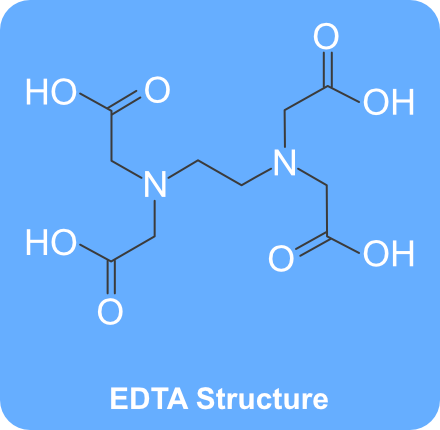Preparation of EDTA solution
Introduction
EDTA (Ethylenediaminetetraacetic acid) also known as Editic acid. EDTA is one of the most used chelating agents.
Chelating agents are chemical compounds (small molecules and peptides) which bind to metal ions and make them unavailable for other molecules/reactions. You can consider them as molecular prisons for ions. So, the ions are present in the solution but virtually absent like Joseph Cooper (Interstellar 2014) struck in another dimension.
EDTA sequesters metal ions such as Ca2+ and Fe3+. EDTA is commercially available in several forms.
Here are few
- EDTA (Molecular Weight: 292.24)
- EDTA.4Na.4H₂O (Molecular Weight: 452.23)
- EDTA.2Na.2H₂O ( Molecular Weight: 372.24)
- EDTA.2K.2H₂O (Molecular Weight:404.45)
- EDTA.2Na.Ca
- EDTA.2Na.Mg
Disodium EDTA dihydrate is common used form in biology laboratories.

Figure 1. Structure of EDTA
Applications
- A variant of EDTA (Sodium Calcium EDTA) is used to treat lead (Pb) and mercury (Hg) poisoning.
- Used in dental procedures to remove inorganic depositions and calcification inside the root canal.
- Used to enhance the activity of preservatives in medical formulations.
- Used to remove limescale.
- Used as a preservative in processed foods and cosmetic products.
- Component of TAE, TBE, DNA loading dye, Tris-EDTA, Trypsin-EDTA.
- EDTA is used to enhance or diminish the activity of enzymes.
Example for reduced activity:
DNA polymerases require Mg2+ for their activity. Presence of EDTA in the solution results in sequestering of Mg2+. This eventually makes Mg2+ unavailable for DNA polymerase and thereby reduces its activity. Chelating property of EDTA is an advantage while isolation of DNA (to reduce DNase activity to prevent DNA degradation) whereas disadvantage in PCR (DNA polymerase activity is needed).
Example for enhanced activity:
Trypsin-EDTA is used for the preparation of single-cell suspension (dislodging the plated cells) from adherent cell culture by breaking the intercellular matrix. Calcium and magnesium ions enhance cell to cell adhesion. Presence of EDTA in the Trypsin mix, sequester the ions that strengthen the matrix. Trapping of these ions weaken the interactions and facilitates trypsin digestion.
Composition
| Concentration | 100 ml | 250 ml | 500 ml | 1000 ml |
|---|---|---|---|---|
| 100 mM | 3.72 g | 9.30 g | 18.61 g | 37.22 g |
| 0.25 M | 9.31 g | 23.26 g | 46.53 g | 93.06 g |
| 0.5 M | 18.61 g | 46.53 g | 93.06 g | 186.12 g |
Table 1.
pH
For most applications, EDTA.2Na.2H2O solution pH 8.0 is used. EDTA solubility at neutral pH is very low, hence pH of the solvent (H2O) must be raised to 8 in order to increase solubility.
For making 0.5M EDTA.2Na.2H2O solution, you need approximately 20g of NaOH. You can either add NaOH in the form of pellets or 10N NaOH solution. In case of pH overshoot use HCl.
Preparation
- Take the 20% less volume of solvent than planned. E.g., if you want to make 1L of the solution, take 800ml.
- Add EDTA.2Na. 2H2O (see the table).
- Keep the beaker on the magnetic stirrer with magnetic pellet. Keep the pH probe to monitor pH.
- Add 75% of NaOH pellets (calculate the rough amount based on 20g/L for making 0.5M).
- Allow the NaOH to dissolve completely. Check the solubilization of disodium EDTA dihydrate as well.
- Add rest of the NaOH pellets one by one. Do not get tempted to add vast amounts at once. You may overshoot the pH.
- Once the EDTA dissolves completely, check for the pH. Use HCl if needed.
- Transfer the solution into the graduated cylinder and adjust the volume.
- Sterilize by Filter sterilization (0.22 micron) or by autoclaving.
Storage
Store the solution @RT for few months.